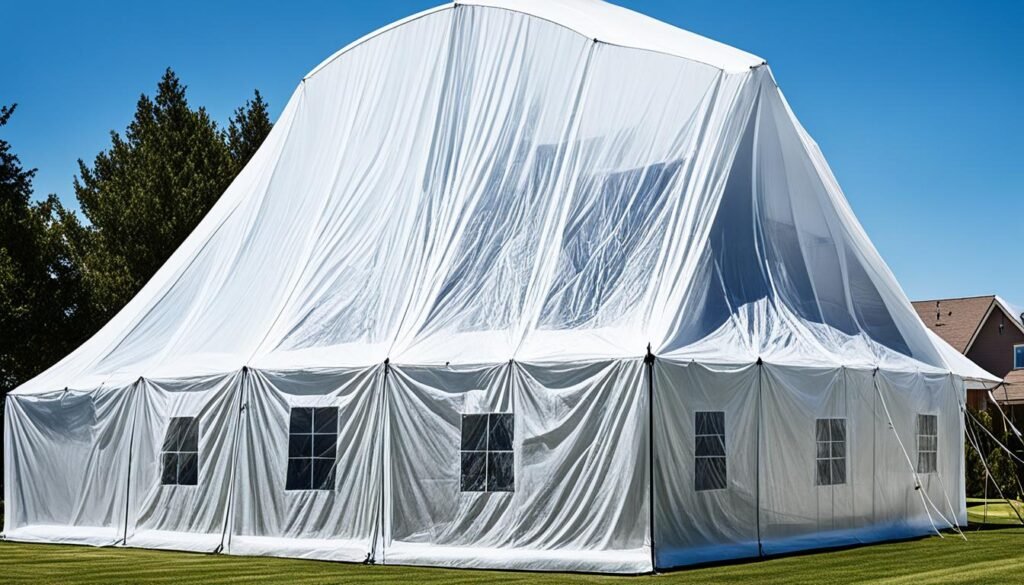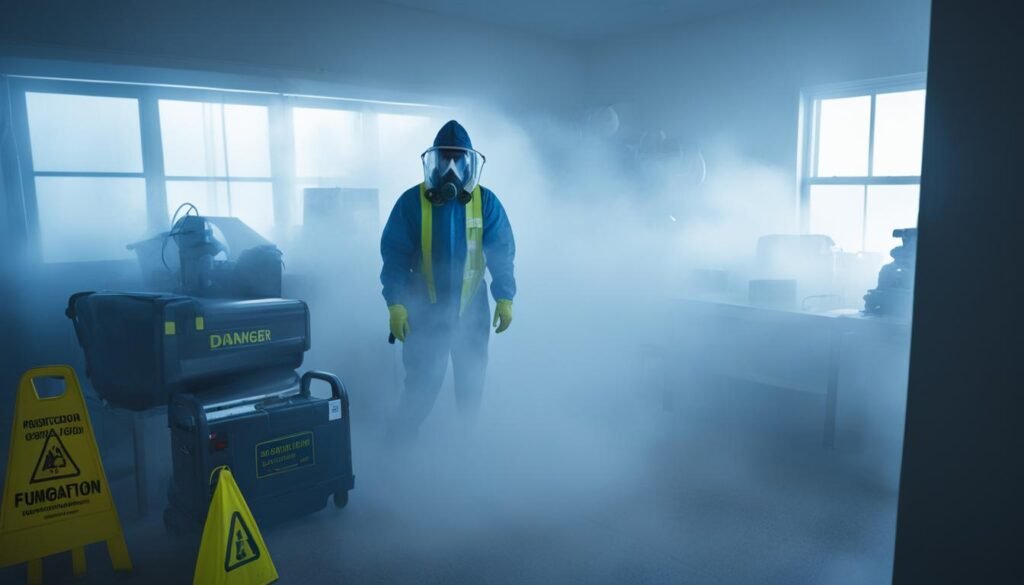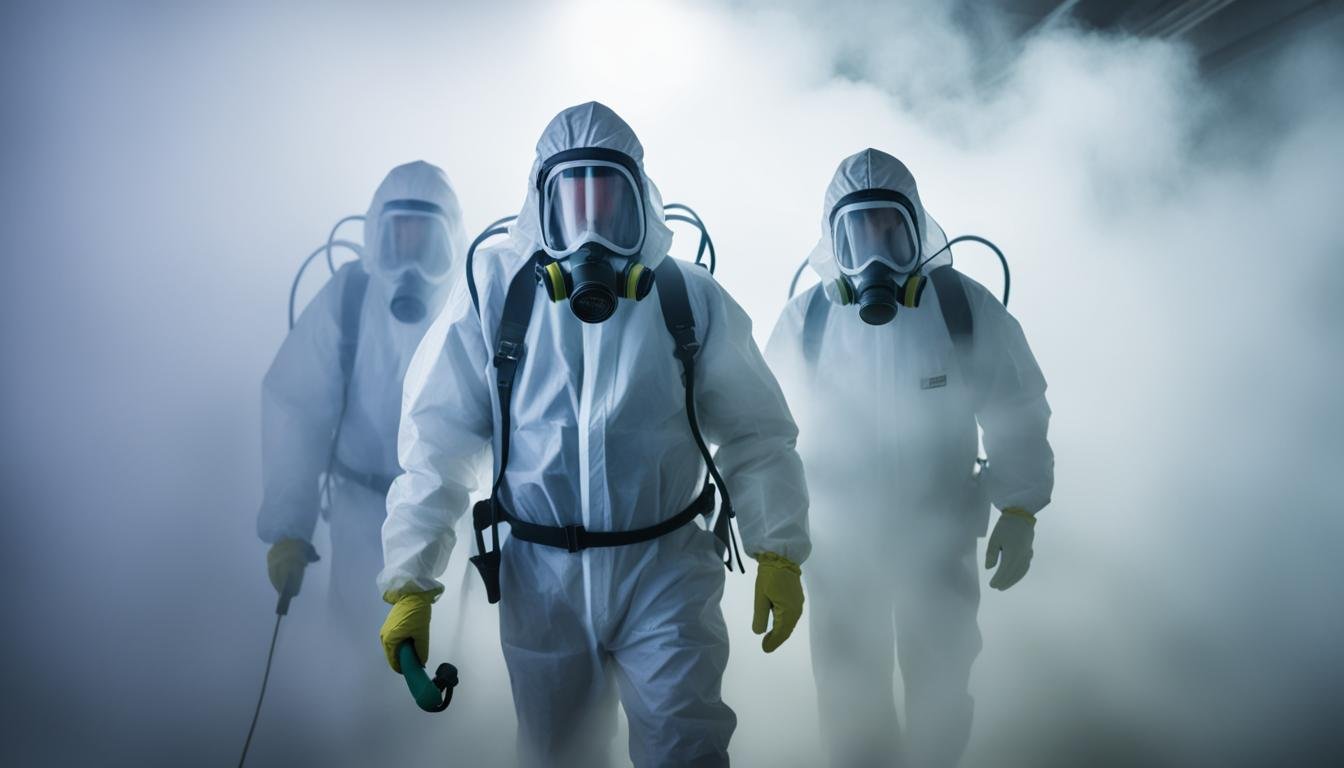Did you know that fumigation is a highly effective method for eliminating pests in homes and structures? It is estimated that fumigation treatments eradicate pests in over 90% of cases, making it a popular choice for severe infestations.
When it comes to pest control, fumigation is a process that cannot be overlooked. This powerful treatment involves treating the entire structure with specialized pesticides in the form of gas, ensuring that pests are eradicated from every corner of the property.
Key Takeaways:
- Fumigation is a highly effective method for eliminating pests in homes and structures.
- This treatment is particularly beneficial for severe infestations that other methods may not effectively address.
- During the fumigation process, the structure is treated with specialized pesticides in the form of gas.
- Fumigation treatments can eradicate pests in over 90% of cases.
- Proper preparation and following safety precautions are essential for a successful and safe fumigation process.
The Fumigation Process
The fumigation process is a comprehensive and highly effective method for eliminating pests from your home. By following specific steps, you can ensure the success of the fumigation treatment:
- Step 1: Preparation for Fumigation: Before the fumigation process begins, it is crucial to remove certain items from your home. This includes food, live plants, and pets. These items can be safely stored in designated areas away from the treatment zone.
- Step 2: Sealing the Structure: The next step involves creating a sealed environment by placing a tent or covering over your house. This process, commonly known as tenting a house, ensures that the fumigant gas does not escape and reaches all areas of the structure.
- Step 3: Gas-Based Pesticide Application: Once the structure is properly sealed, a gas-based pesticide, also referred to as a fumigant, is released inside the tent. The fumigant fills the entire space, penetrating even the tiniest cracks and crevices where pests may hide. This ensures maximum effectiveness in exterminating the pests.
- Step 4: Duration and Monitoring: The fumigant is allowed to remain in the structure for a specified period of time, typically ranging from a few hours to a couple of days. During this time, the fumigation process is closely monitored by professionals to ensure its effectiveness.
- Step 5: Ventilation and Re-Entry: After the fumigation process is complete, the sealed space is thoroughly ventilated to remove any remaining gas. This is done to ensure the safety of occupants before re-entering the structure. It is important to follow the instructions provided by the fumigation company regarding the appropriate re-entry time.
By adhering to these steps, you can ensure that the fumigation process is carried out effectively and that your home is free from pests. Proper preparation, sealing the structure, and the application of a gas-based pesticide all play crucial roles in the success of the fumigation treatment.

Table: Pros and Cons of the Fumigation Process
| Pros | Cons |
|---|---|
| Highly effective in eliminating pests from all areas of the structure | Requires temporary evacuation and displacement of occupants, pets, and plants |
| Can eradicate severe infestations that other methods may not be able to control | Potentially harmful to humans and animals due to the use of pesticides |
| Provides long-lasting results, minimizing the risk of re-infestation | Involves a waiting period before re-entry into the treated structure |
Safety Precautions for Fumigation
Fumigation is a highly effective method for eliminating pests, but it involves the use of chemicals that can be harmful to humans and animals. It is crucial to prioritize safety and follow specific precautions during every step of the fumigation process. By taking the necessary measures, you can minimize the risks associated with fumigation chemicals exposure and ensure the well-being of everyone involved.
Occupant Fumigation Notice
Before fumigation begins, it is important to notify the occupants of the home and provide an occupant fumigation notice. This notice contains essential information about the pest to be controlled, the chemicals used during fumigation, and precautionary measures that should be taken. It serves as a guide for individuals residing in the structure and outlines the necessary safety guidelines to follow.
Vacate the Premises
During the fumigation process, it is absolutely essential to vacate the premises. All people, including pets and plants, must be removed from the structure to minimize fumigation chemicals exposure. This step ensures the safety of individuals and prevents any potential harm that could arise from contact with the fumigant.
Re-Entry Notice
After the fumigation process is complete, a re-entry notice is posted on the property. This notice indicates that it is safe to return to the structure. It is important to wait for the designated time period stated in the notice before re-entering the building. Following this guideline helps to ensure that any remaining fumigant gas has dissipated, reducing the risk of exposure.
Monitor for Effects of Fumigation
Following fumigation, it is crucial to monitor for any potential effects of fumigation on individuals who have been exposed to the chemicals. If anyone experiences symptoms such as headaches, dizziness, nausea, or difficulty breathing, it is imperative to seek medical attention immediately. Reporting any incidents to the pest control company is also essential for proper documentation and further investigation.
Proper Ventilation
Ensuring proper ventilation is key to safely reoccupy the treated structure after fumigation. This step involves allowing fresh air to circulate throughout the building, eliminating any residual fumigant gas. Adequate ventilation is crucial in expediting the dissipation process and creating a safe environment for re-entry.

Conclusion
Fumigation is a highly effective method for eliminating pests in your structure. Whether you are dealing with severe infestations or want a long-lasting solution to pest problems, fumigation can provide the results you need. By targeting pests in every corner of your home, fumigation ensures their complete eradication, giving you peace of mind.
The duration of the fumigation process may vary depending on factors such as the size of your structure and the type of infestation. However, it typically takes several hours to a few days to complete. While the exact cost of fumigation will depend on the size of your structure and the severity of the pest problem, it is generally considered a worthwhile investment in protecting your property from further damage caused by pests.
To ensure the safety and effectiveness of the fumigation process, it is crucial to take the necessary safety precautions and properly prepare your home. Remove food and live plants, unplug appliances, and secure any gas supply. Consulting with a reputable pest control company, such as Your Way Fumigation, will further guarantee that the fumigation process is carried out safely and effectively.
In summary, fumigation offers numerous benefits, including its high effectiveness in eliminating pests, its ability to target pests in every corner of your home, and its long-lasting results. While the duration and cost of fumigation may vary, it is a valuable investment in safeguarding your property. By following safety precautions and consulting with professionals, you can ensure a successful fumigation process that will rid your structure of pests and provide you with a pest-free environment.


